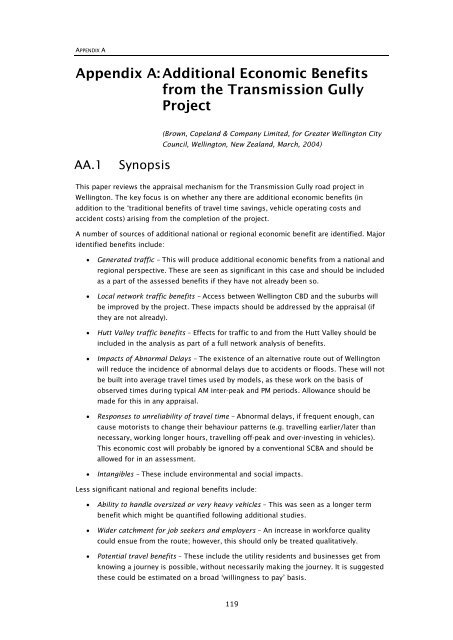Research 350 - NZ Transport Agency
Research 350 - NZ Transport Agency
Research 350 - NZ Transport Agency
You also want an ePaper? Increase the reach of your titles
YUMPU automatically turns print PDFs into web optimized ePapers that Google loves.
APPENDIX A<br />
Appendix A: Additional Economic Benefits<br />
from the Transmission Gully<br />
Project<br />
(Brown, Copeland & Company Limited, for Greater Wellington City<br />
Council, Wellington, New Zealand, March, 2004)<br />
AA.1<br />
Synopsis<br />
This paper reviews the appraisal mechanism for the Transmission Gully road project in<br />
Wellington. The key focus is on whether any there are additional economic benefits (in<br />
addition to the ‘traditional benefits of travel time savings, vehicle operating costs and<br />
accident costs) arising from the completion of the project.<br />
A number of sources of additional national or regional economic benefit are identified. Major<br />
identified benefits include:<br />
• Generated traffic – This will produce additional economic benefits from a national and<br />
regional perspective. These are seen as significant in this case and should be included<br />
as a part of the assessed benefits if they have not already been so.<br />
• Local network traffic benefits – Access between Wellington CBD and the suburbs will<br />
be improved by the project. These impacts should be addressed by the appraisal (if<br />
they are not already).<br />
• Hutt Valley traffic benefits – Effects for traffic to and from the Hutt Valley should be<br />
included in the analysis as part of a full network analysis of benefits.<br />
• Impacts of Abnormal Delays – The existence of an alternative route out of Wellington<br />
will reduce the incidence of abnormal delays due to accidents or floods. These will not<br />
be built into average travel times used by models, as these work on the basis of<br />
observed times during typical AM inter-peak and PM periods. Allowance should be<br />
made for this in any appraisal.<br />
• Responses to unreliability of travel time – Abnormal delays, if frequent enough, can<br />
cause motorists to change their behaviour patterns (e.g. travelling earlier/later than<br />
necessary, working longer hours, travelling off-peak and over-investing in vehicles).<br />
This economic cost will probably be ignored by a conventional SCBA and should be<br />
allowed for in an assessment.<br />
• Intangibles – These include environmental and social impacts.<br />
Less significant national and regional benefits include:<br />
• Ability to handle oversized or very heavy vehicles – This was seen as a longer term<br />
benefit which might be quantified following additional studies.<br />
• Wider catchment for job seekers and employers – An increase in workforce quality<br />
could ensue from the route; however, this should only be treated qualitatively.<br />
• Potential travel benefits – These include the utility residents and businesses get from<br />
knowing a journey is possible, without necessarily making the journey. It is suggested<br />
these could be estimated on a broad ‘willingness to pay’ basis.<br />
119
















